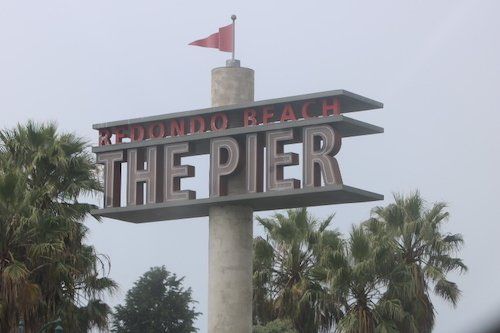Three Piers and a Funeral Self-Guided Tour
eRide a scenic 5 miles and approximately 30 minutes in distance (10 miles round trip and 1 hour ride) beach tour to the historical piers of Redondo Beach, Hermosa Beach and Manhattan Beach. Take Instagram worthy photos at each stop, while enjoying food and drinks from each beach city.
REDONDO BEACH PIER FACTS:
- 70,000 square feet (6,500 m2) in size
- Sits 25 feet (7.6 m) above the water
- 8 months to complete
- Largest “endless” pier on the California Coast
- Seventh Municipal Pier to be constructed on the shores of Redondo Beach

HISTORY OF THE REDONDO BEACH PIER
By the time Redondo Beach celebrated its centennial in 1992, the city’s coastline had seen at least seven piers. In 1889, the pier was a wharf at the foot of Emerald Street, designed to handle the enormous lumber trade from the Pacific Northwest.Two additional wharfs were added in 1895 and 1903. Traffic into the port was so busy that ships had to wait their turn for a spot at one of the piers, as Santa Fe rail cars transported the cargo inland as fast as possible. Erected in 1916, the V-shaped, concrete and steel “Endless Pier” (Wharf #2) was built South of Wharf #1 as a municipal pleasure pier with railroad tracks on one prong, the other for fishermen and tourists.
Built by George W. Harding; Wharf #2 was 450-feet long and the northern leg stood in the spot previously occupied by Wharf #1. It was severely damaged in a 1919 storm and was replaced in the 1920’s by the wooden “Horseshoe Pier” (Wharf #3) built south of Wharf #2 and actively used by the lumber industry. Wharf #3 was manually demolished after the lumber industry phased out. The Endless/Pleasure Pier was damaged by a storm in 1919; and condemned for safety reasons in 1928. The wooden “Monstad Pier” was later erected by Captain Hans C. Monstad for fishing and pleasure boat landings aboard the S.S. Rex, anchored nine miles out to sea.Portions of the Monstand Pier still exist today. In spite of the rebuilt, “mile-long” breakwater that protected the city’s shores, a 1963 winter storm blasted through the area, causing great damage.
In 1970, a second pier known as the “Sportfishing Pier” opened south of Portofino Way and remains in use today. The wooden “Horseshoe Pier” was built after demolition of the Endless/Pleasure Pier. In 1988, the Horseshoe Pier was severely battered by two winter storms, and destroyed by a fire.Between 1988-1995, the southern Y-shaped remnant of the Horseshoe pier that survived the fire, remained open to the public. Completed in 1995, the current seventh generation restored pier is made of reinforced concrete, incorporating design elements that reflect upon the earlier structures.
HISTORY OF HERMOSA BEACH PIER
In 1904, the first pier was built. It was constructed entirely of wood even to the pilings and it extended five hundred feet out into the ocean. The pier was constructed by the Hermosa Beach Land and Water Company. In 1913, this old pier was partly washed away and later torn down and a new one built to replace it. This pier was built of concrete 1,000 feet (300 m) long, and paved with asphalt its entire length. Small tiled pavilions were erected at intervals along the sides to afford shade for fishing and picnic parties. A bait stand was built eventually out on the end. Soon after, about 1914, an auditorium building was constructed; it has housed various enterprises and at present the public rest rooms, the Los Angeles Lifeguard Service, and the local branch of the LA County Library occupy rooms in the building. This pier is municipally owned. The pier’s frontage has changed in appearance over the years and electric train lines used to run along the coastline.
Surfers Walk of Fame. Surfing is a large part of Hermosa’s Heritage. In order to honor our strong surfing history Hermosa annually recognize Hermosa’s surfing legends with the Surfers Walk of Fame. Each year the Surfers Walk of Fame Weekend is held, complete with an Induction Ceremony, to celebrate the newly chosen inductees. Each inducted surfer has been acknowledged by the placement of their name engraved on bronze plaques embedded along the pier.
MANHATTAN BEACH PIER
The Manhattan Beach Pier is a pier located in Manhattan Beach, California, on the coast of the Pacific Ocean. The pier is 928 feet (283 m) long and located at the end of Manhattan Beach Boulevard. An octagonal Mediterranean-style building sits at the end of the pier and houses the Roundhouse Marine Studies Lab & Aquarium. Surfers usually can be seen below the pier. The pier includes the “Volleyball Walk of Fame,” featuring plaques dedicated to past winners of the Manhattan Beach Open beach volleyball tournament. The pier is popular with locals, tourists, photographers, and artists and for fishing. It offers sunsets and vantage points from the shore and hillside.
HISTORY OF MANHATTAN BEACH PIER
Pre-history
In 1897, the Potencia Company was incorporated to develop land in the area and proposed a seaside resort with wharves and piers. The area was named Potencia, but the city of Manhattan was incorporated in 1912 with the word “Beach” being added in 1927. The name was chosen by land developer Stewart Merrill. A pier is believed to have been one of the first features built when the Manhattan Beach community was developed. Two wooden piers were built in 1901, one at Center Street (later renamed Manhattan Beach Boulevard) and one at Marine Avenue called Peck’s Pier and Pavilion. The Center Street Pier was 900 feet (270 m) long and pylons were made by fastening three railroad rails together and driving them into the ocean floor. It supported a narrow wooden deck and wave motor to generate power for the Strand lighting system, but sources disagree about whether the system worked. Part of the wave motor may still be buried in the sands at the shore end of the present pier. This “old iron pier”, as it was called, was destroyed by a major storm in 1913.
Current Pier
Lack of money, lawsuits, storms, World War I and debates about when and where to build another pier delayed Manhattan Beach from having a pier completed until 1920. Engineer A.L. Harris developed the concept of the circular end for less exposure and damage to the pilings by the waves. The pier was completed and dedicated on July 5, 1920. The next version built was a cement pier with a rounded end and it was 928 feet (283 m) long. Octagonal house that now holds a lunch restaurant was completed in 1922. In 1928, a 200-foot (61 m) wooden extension was added but it was destroyed in a storm in 1940. In 1991 the pier was restored to its 1920s appearance with a dedication ceremony in 1992.
In 1928 the pier was extended out 200 feet (at no cost to the city) when a Captain Larsen of Redondo Beach offered to pay for an extension in exchange for the rights to run a shoreboat between the pier and his barge Georgina. On January 9, 1940, 90 feet (27 m) of the extension was ripped away during a winter storm. The extension was never repaired and the remaining section was swept away in February 1941.
In 1946 the pier and adjoining beach were deeded over from the city of Manhattan Beach to the state. During the next four decades the pier would remain a focus of beachfront activity, but Mother Nature and old age took their toll and by the 1980s the pier was in sad shape and in need of renovation. Restoration took place in the early 1990s with a focus on retention of the old time appearance, much like Pier 7 in San Francisco. The original pier had to be fixed as old age and decay required extensive repair, and in fact made it unsafe by the late 1980s (when a jogger was injured by falling concrete).
In 1995, the pier was declared a state historic landmark. It is the oldest standing concrete pier on the West Coast. The Pier is managed by the City of Manhattan Beach Public Works
All Rights Reserved | Manhattan Beach Ebike Rentals
This site is protected by reCAPTCHA and the Google Privacy Policy and Terms of Service apply.


